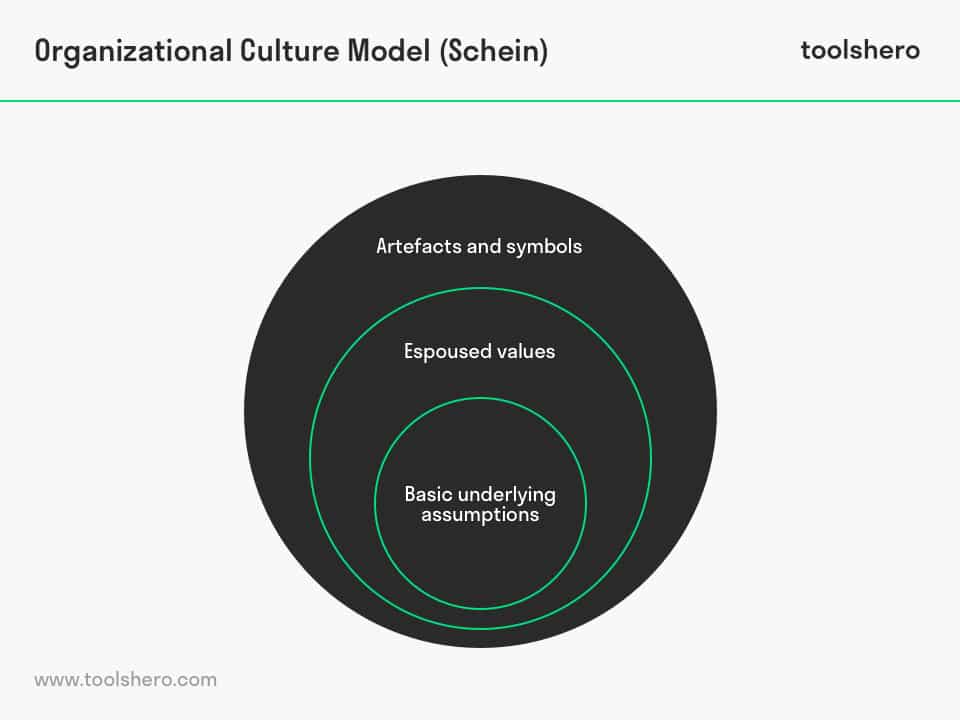Schein’s Model of Organizational Culture

Schein’s Model of Organizational Culture: this article explains Edgar Schein’s Model of Organizational Culture in a practical way. After reading you will understand the basics of this powerful leadership and organizational culture change tool. This article also contains a downloadable and editable Organizational Culture Model template. Enjoy reading!
What is Schein’s Model of Organizational Culture?
Organizational culture is an abstract concept and therefore difficult to understand. But why do people behave differently in different organizations?
In 1980 the American management professor Edgar Schein developed a organizational culture model to make culture more visible within an organization.
Edgar Schein also indicated what steps need to be followed to bring about cultural change.
According to Edgar Schein there are direct and indirect mechanisms within organizations. The Model of Organizational Culture is directly influenced by direct mechanisms. This includes exemplary behaviour, opinions, status and appointments.
Indirect mechanisms do not influence the organizational culture directly however they are determinative. This includes the mission statement and vision of a company, formal guidelines, corporate identity, rituals and design.
Schein’s Model of Organizational Culture levels
Edgar Schein divided organizational culture into three different levels:

Figure 1 – Schein’s Model of Organizational Culture levels
Artefacts and symbols
Artefacts mark the surface of the organization. They are the visible elements in the organization such as logos, architecture, structure, processes and corporate clothing. These are not only visible to the employees but also visible and recognizable for external parties.
Espoused Values
This concerns standards, values and rules of conduct. How does the organization express strategies, objectives and philosophies and how are these made public? Problems could arise when the ideas of managers are not in line with the basic assumptions of the organization.
Basic underlying assumptions
The basic underlying assumptions are deeply embedded in the organizational culture and are experienced as self-evident and unconscious behaviour. Assumptions are hard to recognize from within.
Also known as the onion model
In practice, the three levels of the Model of Organizational Culture are sometimes represented as an onion model as it is based on different layers. The outer layer is fairly easy to adapt and easy to change. The deeper the layer, the harder it becomes to adjust it.
Deeply embedded in the core of the onion we find the assumptions. Around the core we find the values. The artefacts and symbols can be found in the outer layers of the onion and these can be changed more easily.
Between this layer and the layer in which the values are embedded, there may be another layer in which we find the so-called “heroes”; people who play or have played an important role in the organization and who are admired. The core of the onion is made up of assumptions.
These are about “how the world works” according to the all the people who belong to the organization and stem from experiences and perception. These have partly become unconscious assumptions and they are considered to be self-evident therefore they need not be discussed.
Schein’s Model of Organizational Culture and Cultural change
Schein’s Organizational Culture Model also provides points of reference to create cultural change.
According to Edgar Schein, its sensible to have discussions with as many employees as possible to discover the underlying backgrounds and aspects of the organizational culture.
These could be a basis for cultural change. People should be aware that cultural change is a transformation process; behaviour must be unlearned first before new behaviour can be learned in its place.
When a difference arises between the desired and the prevailing culture, cultural interventions should take place.
The responsibility lies with senior management supported by a personnel department. This requires a comprehensive approach. A new logo, corporate style or a customer-orientation training will not suffice. It is important that results are measured and that good performance is rewarded.
Schein’s Model of Organizational Culture template
Start describing the different layers within the culture of an organization with this ready to use Schein’s Model of Organizational Culture template.
Download the Organizational Culture Model template
This template is exclusively for our paying Toolshero members. Click here to see if a membership is something for you!It’s Your Turn
What do you think? do you recognize the practical explanation of Schein’s Organizational Culture Model? What are your reference points for organizational culture change or culture creation? What are the today’s direct mechanisms and what can we learn from them?
Share your experience and knowledge in the comments box below.
More information:
- Schein, E. H. (2010). Organizational Culture and Leadership. Jossey-Bass.
- Schein, E. H. (2006). Organization Development: A Jossey-Bass Reader. J. Gallos (Ed.). John Wiley and Sons.
- Schein, E. H. (1984). Coming to a New Awareness of Organizational Culture. Sloan Management Review.
How to cite this article:
Mulder, P. (2013). Schein’s Model of Organizational Culture . Retrieved [insert date] from Toolshero: https://www.toolshero.com/leadership/organizational-culture-model-schein/
Original publication date: 04/07/2013 | Last update: 01/09/2024
Add a link to this page on your website:
<a href=”https://www.toolshero.com/leadership/organizational-culture-model-schein/”>Toolshero: Schein’s Model of Organizational Culture </a>













9 responses to “Schein’s Model of Organizational Culture”
May I have permission to use the “onion” figure?
Hi Shelia, yes you may if you make a source refer to our website / article. If you have any other questions, please let us know. Kind regards, Vincent
What year was this published?
Hi Shaniece, this article is published in 2013 by Patty Mulder, check the citation box in below the article. If you have any other questions, please let us know. Kind regards, Vincent
Great article and I love “onion” figure is easier to understand which one is high and non visible. Basic assumption are difficult to recognized however, hidden discrimination or feelings are a good example of it.
Well, organizational culture is one the most pivotal build blocks for an extraordinary duty station. In fact, it is the only viable point of difference for an establishment. A work culture is the summation of values and rituals- that serve as a ‘fixative’ to integrate the workers of the establishment. It is a kind of civilization in the corporation. However, without proper management, it is nearly impossible for a chairperson to develop a healthy work culture.
Thank you for your comment and sharing your experience Alan.
Thanks a lot for this information. It is very helpful and free of charge. Great job toolshero!
Thank you for your feedback Allan. I am glad that you found the article helpful.